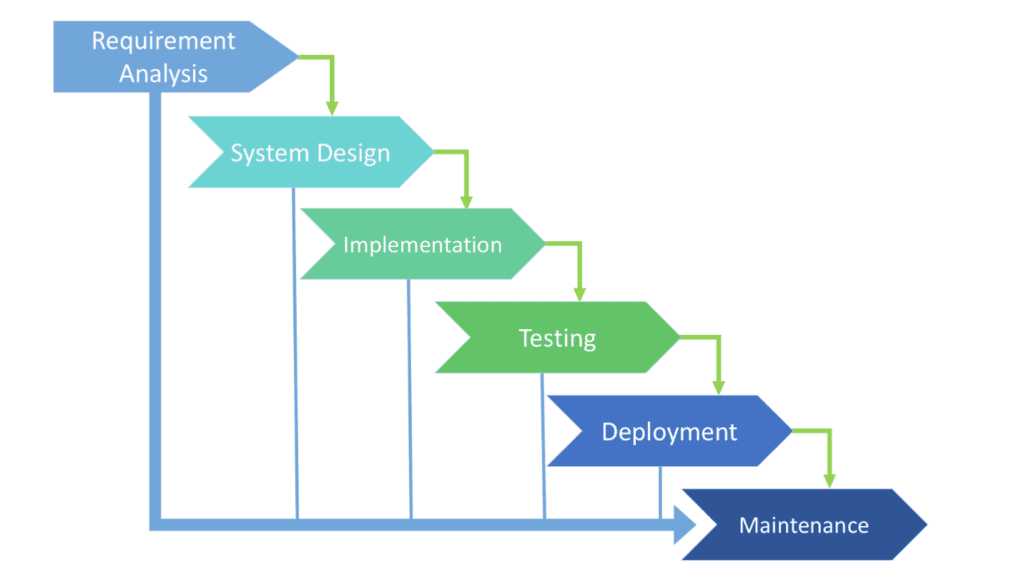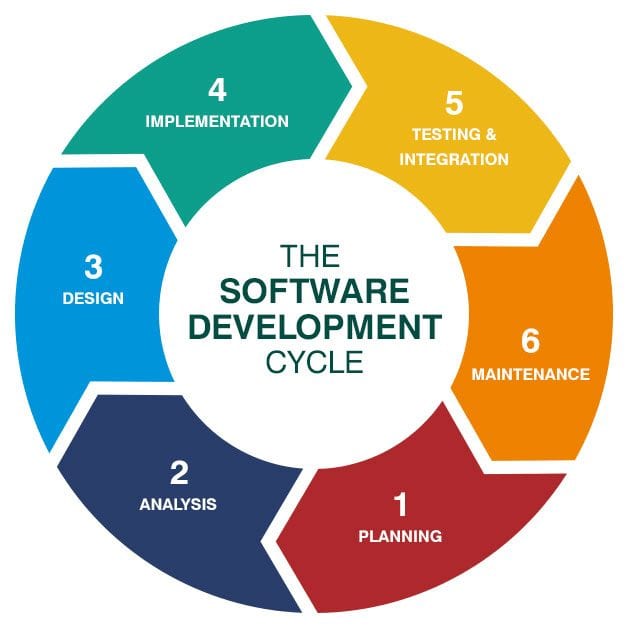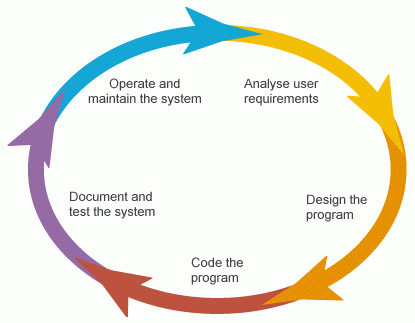Software Development Life Cycle: Basics, Stages, Models
An approach to creating a software product is usually regarded to as “software development life cycle” (SDLC), also known as “application development life cycle,” or simply “software development process.” As building software is inherently complex and demands a long list of skills from the development team, there is a multitude of different SDLCs to address projects of different scale and complexity.
But what is a SDLC is, and how to pick the right one?
Let’s try to answer these and other, adjacent questions.
Mục lục bài viết
What is Software Development Life Cycle?
In essence, a software development life cycle is a roadmap for working on a digital solution. In other words, SDLC is a blueprint designed for a team to create, maintain, and fix digital products. The steps of a software development life cycle process depend on the project size and project goals. Each step also provides a general map on how it should be completed. In most cases, every development team creates its own software development cycle, or adopts one of the models, which we will explore further.
How Does a Software Development Life Cycle Work?
While SDLC cycles provide an overview of tasks for a project, they are not a ready-to-use manual. A SDLC is not set in stone: there are different models and examples of software development life cycle. The latter depend on project complexity, and so do the many software development life cycle methodologies. Nevertheless, the core idea of a software development life cycle remains – it is an order of tasks aimed at creating a digital solution.
Benefits of Software Development Life Cycle
The key reason behind adopting a clear SDLC is control over the development process. A working plan, conflict management between participants, and budget management are other big advantages of software development life cycle.
Thus, software development life cycle allows for:
-
Having overarching control over software development process
-
Improving resource management and cost-effectiveness
-
Gives teams a clear action plan
-
Improves cooperation between participants
What is important to remember is that all the advantages of software development life cycle will not work for teams on their own. If project managers lack expertise or some participants refuse to follow the process, the cycle will fall apart, influencing the quality of the final product.
Software Development Life Cycle Models
There is a host of different SDLC models that help in different types of software development projects, even in cases when the client does not have a clear vision of what they need.
Waterfall Model
In the SDLC Waterfall model, all the steps should be finalised before the development can start. One of the basic preconditions of the Waterfall model is to receive approval on each stage before the team can move on to the next one. This approach can be effective in risk mitigation in the software development life cycle. Here, the Waterfall model uses a Business Requirements Specification (BRS) that helps teams evaluate each step. While some software development companies still offer this model of cooperation, this type of a software development life cycle is less popular than other, more flexible models on our list.

V-Shaped Model
The V-Shaped Model is similar to Waterfall, and can be considered as its extension. Therefore, the methodological basis of the V-Shaped model is to guarantee the completion of tasks on one stage before moving on to the next one. This model also divides the development process into different challenges. Another feature of the V-Shaped model SDLC is constant trialing, which makes it stand out among some other development lifecycle models.
Iterative Model
The Iterative model has many software development cycles that are segmented into smaller cycles. In addition, this model ensures a solid start for a software product with the help of trialling. Among the concrete software development life cycle model examples here, Rational Unified Process allows for avoiding the confinements of some other software development life cycle models. As the dynamic systems elaboration method used in this model divides the cycle into several smaller ones, allowing for micromanagement, Iterative model SDLC is among the most reliable approaches to the development process.
Spiral Model
The Spiral model is a universal software development life cycle model. Similar to the Iterative model, it emphasizes the value of smaller cycles within larger SDLC cycles. How? the Spiral Model SDLC closely puts together all the key steps of the development process. This software development life cycle model eliminates the complexities of any traditional software engineering lifecycle. This level of efficiency comes at a cost: developers will spend more time on tasks. Still, the Spiral model is one of the most useful approaches to gradual improvements of a product among software development life cycle models.
Big Bang Model
The Big Bang model has no guidelines at all. This software development life cycle model was conceived to help navigate projects where client does not know what the final software product will look like. More specifically, the Big Bang model is built for projects were the initial information is so vague that the model itself does not involve a specific process beyond its concepts or any planning: the team needs to figure the project out as they go. Where would one apply it? The Big Bang model SDLC fits for small development efforts, small development teams, and might also be suitable for short-term experiments.
Agile Model
The flexible development approaches of the Agile Model help to ensure a streamlined software development process that allows for fast adjustments. The Agile SDLC model includes XP and Scrum approaches, which cover the SDLC cycles with two-week development sprints. The team shows the results to the client after each sprint as the client also leaves comments on what was created in two weeks time.
One of the most popular models for software development life cycle, Agile is aimed at more frequent releases and visible results. In Agile, the software product emerges gradually, and the client gives feedback every step of the way. The models also helps collect feedback and measure different aspects of the development process.
Software Development Life Cycle Stages

Stage 1 — Planning & Requirements Analysis
At the start of software development life cycle stages, the need to attract the most talented and experienced engineers inevitably arises. By considering the demands of the client, a skillful crew can create a reliable foundation for the rest of the software development life cycle phases.
This stage has a number important steps. First, the team working on the project conducts a preliminary analysis to discover the aims and issues of their client. Based on the results, they propose a set of possible solutions, with a budget for each.
Stage 2 — Defining Requirements
The sequence of software development life cycle stages continues with a deep dive into the requirements, after the client has chosen a software solution. The team analyses documents related to the project, evaluates the client’s existing ecosystem. This is one the software development life cycle steps that some consider transitional, performing it alongside planning and requirements analysis.
Stage 3 — Designing Product Architecture
Having fully analysed the client’s requirements on previous software development life cycle stages, the developers create several product architectures and show them to the client.
The chosen architecture is then finalised in a Design Document Specification (DDS) and evaluated by all sides in terms of risks, operational reliability, universality, and cost-effectiveness. This architecture becomes the foundation for all next stages of software development life cycle and the software product in question.
Stage 4 — Developing the Product
One of the most critical software development life cycle phases, this one aims at producing working code and showing results to the client. The development takes the majority of time in any project. Often, the project exceeds the initially estimated time: the client might consider adding something to the project scope in the course of the development process. In some SDLC models, the product can change in the process of the development.
Stage 5 — Testing the Product
After all the preparations on previous stages of software development life cycle are completed, quality assurance engineers start scouting for bugs. Testing is another crucial step among the SDLC life cycle phases as it allows for fixing critical problems before they will lead to critical loses.
Even though testing procedures may appear on other software development life cycle stages, as a separate one, testing provides a detailed map of breakdowns that need to be fixed.
Stage 6 — Deployment & Maintenance
After the product is release-ready, the next action in the order of software development life cycle steps is to display the finished software solution to the client.
To guarantee the proper work of the finished digital solution in the future, after all the SDLC life cycle phases are completed, the client can order general product maintenance to fix different issues (which inevitably emerge with any modern software product). This step completes the software development life cycle.
Software Development Life Cycle Diagram
Here is a general software development life cycle diagram:

Software Development Life Cycle Examples
Among the explanations of software development life cycle with examples, the most useful ones are those that explore the aforementioned models and stages in detail. Let’s take a look at two interesting models that are not widely used.
Waterfall Model
In practice, Waterfall Model SDLC starts after receiving the list of terms and conditions from the client, which is commonly reflected in a Customer Requirement Specification (CRS). Based on it, the analytical, financial, and technological departments summarize the project in a Software Requirement Specification (SRS). Then designers prepare several high and low-level design diagrams for developers. After the development stage is over, testing experts examine the solution’s consistency with the project’s Software Requirement Specification. If there are no issues (or after the existing issues are dealt with), the product is presented to the client.
Among all the software development life cycle examples, the Waterfall model is the most client-facing option, giving them extensive control over the project. On the other hand, the model lacks in flexibility, which can affect both the client and the team they hired.
Big Bang Model and the Definition of Requirements
On the first stage of all the software development life cycle examples, it is crucial to get what the client needs from the developers. Often, the initial information is scarce and vague, and it is incredibly difficult to find a starting point. The situation can be so hopeless that an approach with no rules emerged — Big Bang model.
How to approach such projects?
Among the techniques that help the customers clarify what they actually need, brainstorming, employee and management interviews, focus groups, surveys, and mind mapping are the most effective ones for the team working on such a project. Accuracy is key. For example, a survey needs to consist of clear, well-defined questions that need short answers.
Software Development Life Cycle Best Practices: Secure SDLC
Beyond software development life cycle examples, let’s look at arguably the most important practice in our area of interest today.
Secure SDLC
The importance to address the modern cybersecurity concerns called for creating a secure SDLC. What does this mean for a software development life cycle?
First, teams should identify policies and criteria that would guarantee the solution’s security at the very beginning (Requirements Gathering and Analysis stage). Then, it is better to implement threat modeling — test software in several scenarios and environments where security may be at risk.
As for other stages, both the developers and quality assurance engineers should approach their work with potential security issues in mind. Meanwhile, the deployment stage should use state-of-the art intrusion detection systems.
Get in touch
Share this article











